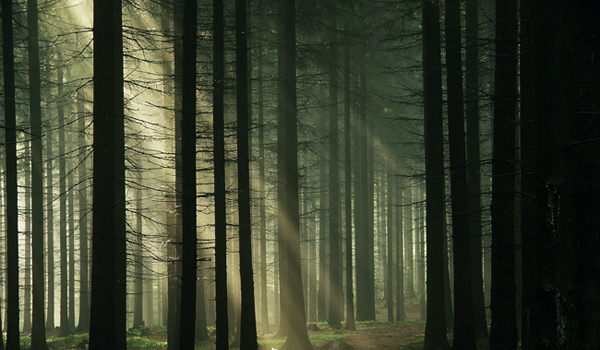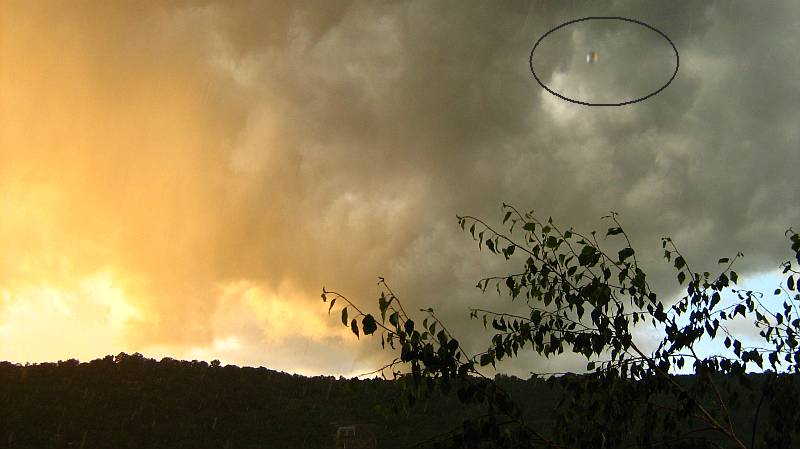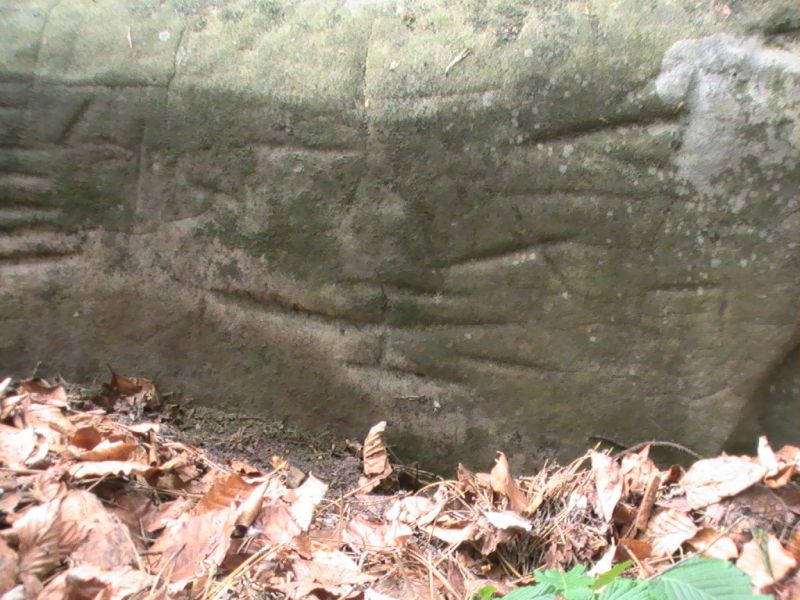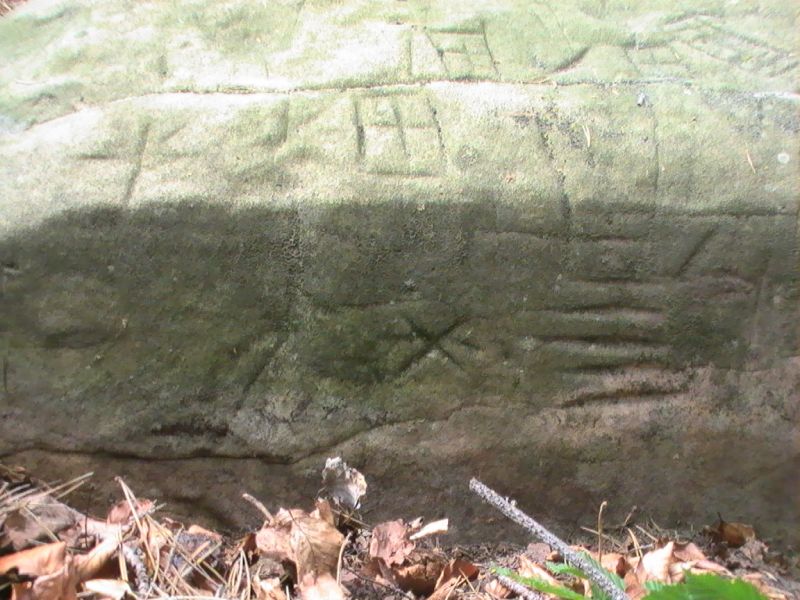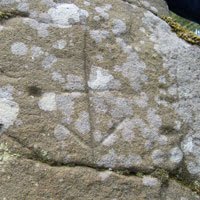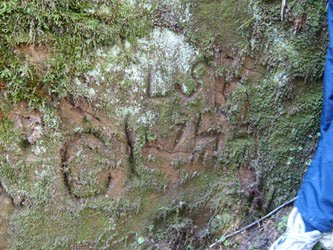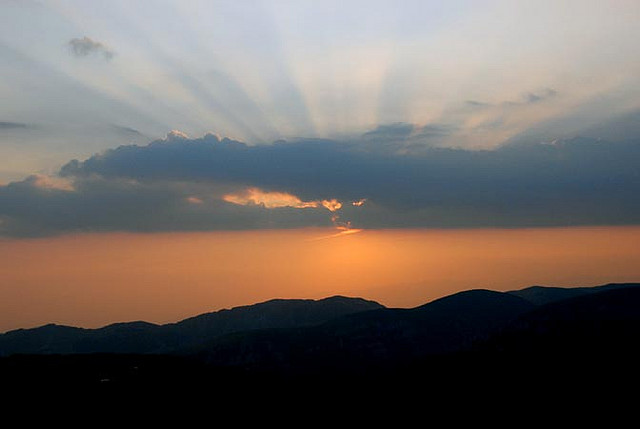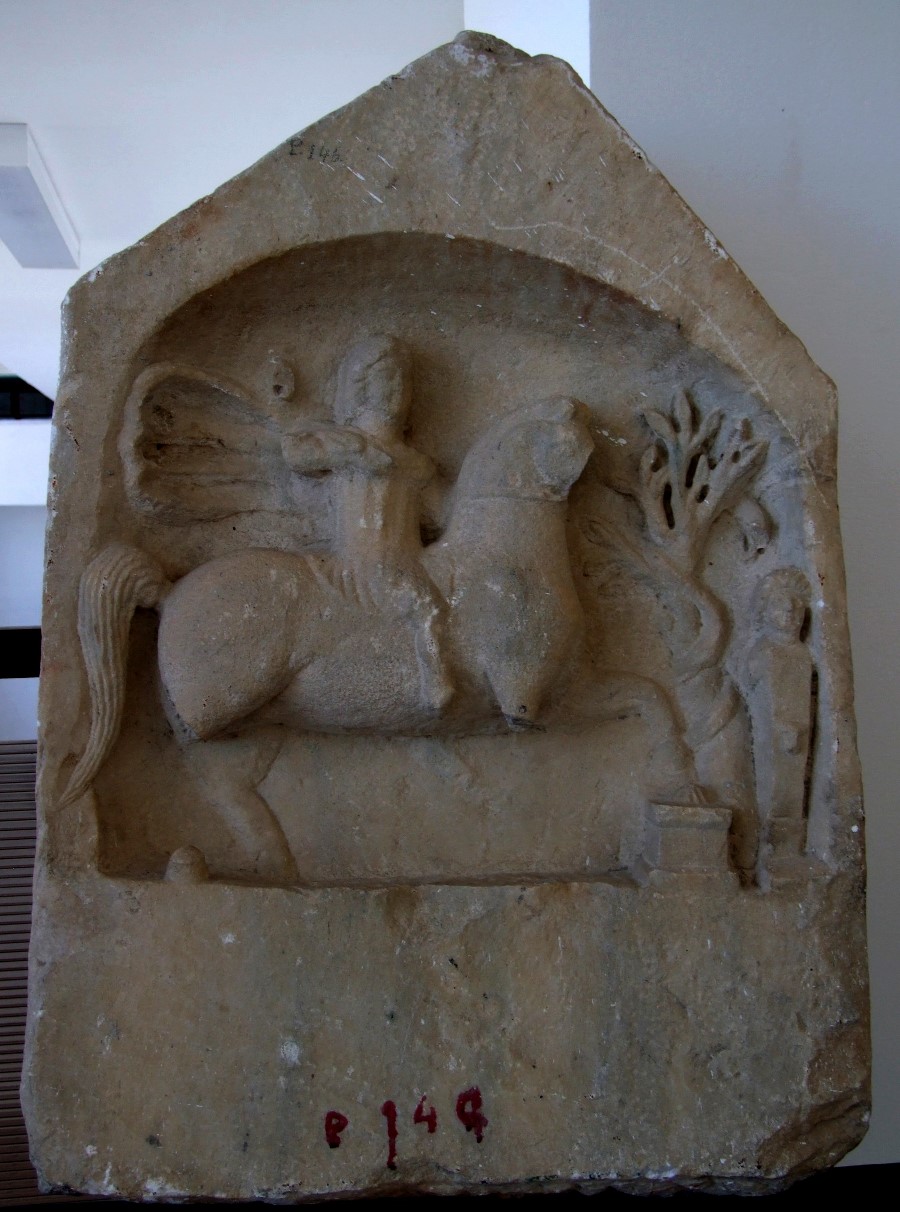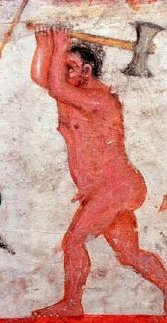|
Pegasus
Research Consortium
|
|
Lisa2012's Collection
Member of
AboveTopSecret.com
(Edited and Additions by Pegasus)
|
Bucegi Mountains, Romania
The Mysteries Page Two
|
| The Bermuda
Triangle of Oltenia and other unsolved mysteries....ROMANIA
Originally posted by lisa2012
ATS
Post ID 10557277
The Bermuda Triangle of Oltenia and other unsolved
mysteries....ROMANIA
Somewhere around halfway between Rimnicu Vilcea and
Targu Jiu, Polovragi, we enter the foothills of the Gorges "Olteţului
Keys", keys that separate them from the Parang Mountains, a place that
holds many secrets.
Paranormal enthusiasts call the "Bermuda Triangle of
Oltenia". Odd things have happened here in the past; even deaths of cattle
in their herd eyes, the eyes of shepherds and sheep at a wedding feast,
when food and drink volatilized on the table making some wedding guest
crazy...
... stories about all these mysteries, but also about
the existence of corridors throughout the area of the Carpathians, as well
as in the Danube and Bucharest, can be heard live on land with increasingly
frequency.
However there are many unsolved mysteries, either because
they are not spoken about, and deemed likely that the impact of information
on people would be too high or because I still can not find answers ...
or a "conspiracy of silence"!
Bermuda
Triangle of Romania - Hoia-Baciu Forest
The following sites have many
stories of sightings and strange lights;
I have had in thirty
years ago when I was a teenager, three paranormal experiences in Hoia-Baciu
Forest. When driving to a friends house who lived in the forest Baciu sheepfold.
At one point we stopped on the crest the hill to watch the city. It had
already night. At one point appears as a bright light suddenly, like a
fire road, facing the city, which curve continuously. I ran to the woods
to find the source of the lights, but it is away from us as we approached.
Eventually disappeared, actually. The second experience was all through
that period, one night when I was in the woods with a friend, Jeno. At
one time it lit the whole forest that day, the sheepfold by power lines,
the level of 1.70 to 1.80 meters. Raise their hands and some disappear
into the darkness. Then, the situation has reversed. Top and bottom was
lit remained in darkness. I have never come to an explanation related to
this event. Third paranormal experience: I was in the courtyard of his
father’s house, the Grigorescu neighborhood, near the forest Hoia. At
one point there was a ball, rather than as two golf balls, floating through
the air. It seemed like jelly, but not shaking. Down the hill, coming from
Hoia at a constant height from the ground. I tried to hit with a bat, but
avoided, as a being. Eventually passed the neighbors fence and I lost sight
of… Hoia Baciu Forest by kaotic.ro
..
Hoia-Baciu Forest
Hoia
Baciu Forest Vs Devil’s Triangle (Bermuda Triangle)
November 08, 2010 - The Hoia-Baciu
Forest is located near Cluj-Napoca, Romania and is locally referred to
as the Bermuda Triangle of Romania. The Hoia-Baciu Forest was named after
a baci that disappeared in the forest with a flock of two hundred sheep.
In the Romanian language a baci is a leader of a shepherd community. The
search for this man went on for days and spanned out across several counties,
but they found no trace of the man or his sheep
Most of the locals are genuinely
afraid to enter or come near the Hoia-Baciu Forest. They believe that most
people to enter the forest never return. Those that have been fortunate
to return from their visit into the forest have claimed to have suffered
from various illnesses as a result of entering the forest. Many of the
complaints include rashes, nausea and vomiting, migraines, burns, scratches,
anxiety, and other strange bodily sensations.They have also witness several
strange unexplained events which occur within the forest. The most common
unexplained activity includes seeing mysterious orb-like lights, female
voices, giggling, apparitions, and cases of people being scratched.
The orb-like lights have been
seen within the tree line. Some can be seen at ground level, yet others
are up at the top of the tree line. When using a thermal, these lights
don’t seem to be producing any heat signatures. Some accounts have talked
about lights that shoot straight up in the sky from the forest.
Haunted
destinations: Hoia-Baciu Forest, Romania
Hoia-Baciu Forest - This forest,
sometimes called the "Bermuda Triangle of Romania," is located in the middle
of Transylvania. It was called Baciu Forest after a shepherd (the chief
of a given shepherd camp is called "baci" in Romanian) disappeared inside
the forest with his 200 or more sheep. He was searched for everywhere,
including in nearby counties, but nobody knew where he was or saw him after
he entered the forest. In addition, further disappearances, as well strange
sensations of sudden illness, headaches, dread, or other odd sensations
has been reported by some visitors. Sometimes mysterious lights and orbs
have been observed amongst the trees as well.
Dark
Destinations - Hoia-Baciu Forest, Romania
I tried to go inside the forest for some more photos
and I did, but just about 10 meters deeper. I tried to capture some strange
mushrooms, I took about ten shots but I couldn't focus. All the time I
was looking around and backwards to be sure that I still can see the people
in the cleaning. I, myself couldn't understand why am I so afraid in the
middle of the day. Finally I had to come out of the forest.
It often happens to some of us that we hear strange
and scary stories our whole lives about something. So scary stories that
you shut them out of your mind. I can swear that I've totally forgotten
all stories when I began my trip. Back home, it took me a week to think
about it and to find the answer for being so scared to go deeper in the
forest. There is no answer, now I remember. It happens to each and every
human, entering the Hoia-Baciu forest.
From ancient times, villagers found themselves assaulted
by unexplained feelings of nausea, anxiety, feelings of vomiting, headache
and even skin burns occurred to all who have stepped in the forest.. They
don't like to talk about these things but they advice everyone not to go
there.
The Hoia forest is connected with the Baciu forest,
mentioned as Hoia-Baciu forest but also as the "Bermuda Triangle of Romania".
The forest is considered one of the most active spot in the world regarding
apparitions and various unexplained phenomena like light observations of
various shapes and colors, strange shadows, voices and human faces.
Esoteric specialists from around the world, teams
of famous scientists from Germany, France, the United States and Hungary
managed to capture on film immaterial or material structures and forms
appearing in front of curious, whether it was night or noon. Some are seen
with the naked eye and some only on photos or videos.
I hope I didn't scare you too, with my story.
Walk
in the Hoia forest-wildflowers
Once inside Hoia Baciu forest or even travelling
near the forest's edge, you have the feeling of being watched behind every
tree, a sensation of unexplained anxiety. That's the first thing that happens
to everyone and happened to me too.
Dr. Adrian Patrut, president of the Romanian Society
of Parapsychology , has been studying occurrences in the forest since the
early seventies. He has devoted a good part of his life studying and investigating
the paranormal phenomenology of forest.
I would never, ever doubt that these things are
really happening but I could accept explanations only from scientists,
not ghost hunters. They have no explanation anyway.
Here is the video with "Destination Truth" team's
adventures: Note: Video blocked in USA due to NBC
copy right claims
Walk
in the Hoia forest-part 2
It's show time above the Hoia forest. It's sunset
and storm just started.
Almost each storm is a spectacular show of color
or most often of lightning, especially at night.
As I mentioned in my previous post, the Hoia-Baciu
forest is considered one of the most active spots in the world regarding
apparitions and various unexplained phenomena like light observations of
various shapes and colors, strange shadows, voices and human faces.
Look at the next photo, there is a shiny spot in
the black circle. Is it just a raindrop on my lens? I took the photos in
a continuous sequence, if it is a raindrop, it must be on the same spot
at the next photo too.
..
Hoia-Baciu Forest
Storm
above the Hoia forest-part 3
|
| Secret
corridors?
Originally posted by lisa2012
ATS
Post ID 10557277
This will explain something that one of the members
asked in Regards to Myths and Legends ......
Zamolxe-with-wolves "Zamolxe's Cave" (which is believed
to pierce beyond the mountains, in Transylvania), so called old and reported
in the literature of travel writers in the nineteenth century, like Grigore
Alexandrescu (1842) and Alexander Vlahuta (1901). Above the cave are ruins
of ancient cities. Arcinna,
listed on the map of Ptolemy, the famous geographer of antiquity, the link
between the cave and the city is making a secret gallery.
They say that man-god Zamolxis passed through secret
Sarmisegetuza galleries. According to legend, the power that Zamolxis held
was amazing, being able to change his appearance to that of the old couple.
The cave of Polovragi, supreme god of the Dacians in deep to get out over
the mountains to the city Sarmizegetusa. When cavers first looked into
the cave about 100 years ago they were amazed to discover shod human footprints
dating back 2,000 years, undoubtedly marks of the Gauls. Or something else?
Visiting the cave is reached before the throne Zamolxe,
which says that the great bulk of the state. Legends talk about the well
site that I feel most of the visitors see, but also about those who reject
the cave. Then comes the place where the monk Pachomius, who visited the
cave through the nineteenth century, drew the candle smoke darkened the
image of Death. There are other wonders, faces the Gauls, mythological
animals, and the ceiling "Tears of Zamolxis continue to fall". Certainly,
we have that constant temptation to which it subjects the cave of treasure
hunters in search of Dacian treasures. Often, the guides have found broken
metal gates at the entrance. "Tourists" with metal detectors have been
lost through the galleries without electricity. And did not come back!
They say beware the curse of Zamolxis Dacian treasures hidden here... And
the place is not singular ... About the curses that afflict those who find
the treasure, you know... But sare such "acts" a curse in this context?
Since nobody returns to tell!
The cave has 3 levels:
the first one is for the tourists, shaped like an S; the next two are harder
to cross.
The first level has many names,
the most known are Grota Pustnicului (The Monk’s vault- because some
say that the cave was discovered by a monk, Father Teofil, after he had
dreamed of the place and the way to it) or Grota lui Zamolxe (Zamolxe’s
Vault) – Zamolxe is an ancient Dacian priest/god. It is said this cave
was used by Zamolxe and his people to hide and pray when they were under
attack.
At this level you can find
one of its most peculiar attractions: somewhere in the stone there is a
groove, like a pail, filled with water. The strange thing is that once
the
water is removed, it starts to “rain” from the ceiling, and it stops
when the pail is full with water again.
Another attraction is Hades
Well, a coalpit inside the Ialomiţa Cave: nobody could explain yet why
any kind of light just dies inside this groove.
The second level hosts two
Dacian thombs, and the third level a glaciar lake.
Bucegi
Mountains Legends
Earth is alive
in the Capital Bucharest Romania
Those who worked in the subway tunnel say they saw
and heard things hard to believe. Mircea Ioanid, who retired from working
in the subway tunnel, recalled with some horror stories in the '80s what
was witnessed in the dirt carried out of the underground workings.
"I was not the only one who lived such occurrences,
but the only one left alive after all that happened. Because the earth
has swallowed simply others. Earth was alive, literally. And I was the
youngest driver and power, not as I feared, with a double, but when I recall
those experiences now my hair raises on my head with fear."
Ioanid claims that in 1982, one of the excavators unearthed
a bizarre corpse. "It was around 2 meters and was wearing something strange,
a sort of red robe and a black mask on his face. The skin was brown. What
amazed us all was the feeling that the man was still alive. His eyes were
wide open and his face, though handsome features, inspired fear. One of
my colleagues even made a joke and said that it should look like Satan,
if one exists. I do not know if it was a coincidence or not, but a few
days later, this fellow found him dead. At autopsy, doctors said they had
all the internal organs scattered, as if something exploded inside him.
"
But what amazed the few workers who saw the corpse
was that strange object in his hand that looked like a sledgehammer that
ended more like a two-edged ax. "And also the hand gun revelation startled
us, and especially the fact that I had never seen anything like that even
seemed that he had been underground for hundreds of years, did not have
any rust on it. The gun and the corpse were isolated by a specialist that
came, but that night they disappeared, surprisingly... the Security Services
came and we turned on all sides, we suspected that we understood the class
enemies and I hid the body. But we passed it. Instead, my colleagues have
gone, in turn, swallowed by the earth, without anyone to trace them in
May. When I was with the two missing, I could not forget even now that
he pulled the animal roar, screaming, trying to hang on nails with a touch
of earth: "Do not let him take me My mother's mercy on me ..." I'm the
only one they missed because I requested a transfer to another site." |
| Department
Zero
Originally posted by lisa2012
ATS
Post ID 10551848
Confirmation of these events is found even in a daily
(newspaper) that recounts at length about the mysterious disappearance.
It refers to two men from Braila who go on a trip and they find a metal
chain and one of them touched it and disappeared;
In the spring of
1990, Caesar was appointed technical director of Department Zero, and in
1992 have been clarified the relationship between DZs and the Romanian
Presidency. Head of state ordered the total subordination and politicization
of dz; but Caesar presented some of the shocking realities that have been
discovered over time and their enormous implications in the stability of
the country, so that the President has given way to confusion like the
old agreement, the is quasi-independent DZ.
In May 2003, Caesar was visited
by an important character for one issue in particular, meeting the request
came through SRI Romanian Secret Service. A helicopter brought this gentleman,
tall, wearing a black suit and dress stylish, but arrogant. He had a cane
with ivory handle and gold inlay. His face expresses strength and green
eyes had a strange effect, radiating an unusual cold. It was presented
as the senior Massini. He was very sure of himself and create the impression
of a person who used to give orders. He was leading one of the most venerable
major Masonic Lodge in Europe and was one of the most influential Masonic
organization in the world: the Bilderberg Group.
Caesar realized that global
Freemasonry sought to acquire in a short time control of a secret locations
in the Bucegi mountains, excluding any form of publicity and wanting even
concealing the existence of this site graduated from the power of Bucharest,
the representatives of the elite had access there.
What could cause the Masons
of the world's largest to focus all of great interest to Romania! There
are some predictions made by two very big secret in the early Christian
saints past and future of Romania in the context refers to all mankind.
There is also a very valuable parchment vast library of the Vatican exhibit
the same problem with the Romanian territory, a situation almost inconceivable
mentality and ego states and major world powers.
The secret archives of the
Museum of History in Vienna, is a very old document that sets extremely
distant historical past and also fabulous civilization that existed at
that time in Romania. Here we have all these different sources refer to
the same things. There are many aspects that are correlated. Prophecy says
it is a matter of just a few years later for signs that will draw attention
to this area of the world.
Sunday, February 13, 2011
2003
IN BUCEGI MOUNTAINS:Romania... Linked to underground world
|
| Mt Olympus
of the Hyperboreans
Since I have discovered Osiris's origins which appear
to be in the area of the lower Danube as the God
Zamolxis, I have also had my own thoughts reinforced that the Egyptians
came from this area also. This all relates to following the Sky Column
or Pillar/World Axis/Polaris religion. The Djed Pillar is a representation
of this. This is a religion that the Pelasgians adopted and then spread.
We have here therefore an important document from the
Italo-Greek antiquity, a document which gives us an absolute certitude
that the prehistoric Olympus of the theogony, the Olympus from the ends
of the earth, according to Hesiod, was that mountain on which were the
legendary columns of the sky, Atlas from the country of the Hyperboreans,
Olympus atlantiacus at Calpurnius (IV. v. 83), today
Omul Peak of Bucegi Mountains, near the Lower Istru, where there
are, apart from the columns, the other monuments famous in the history
of theogony, the figure of Zeus aigiochos and the cyclopean altars.
SOURCE: Is
Atlantis origins in Hyperborea? Pillar of the Sky origins..
Reference: The
Sky Column from the Carpathians as symbol of the Egyptian trinity |
| Mysterious
Energy in Bucegi Mountains
Originally posted by lisa2012 ATS
Post ID 10551891
Mysterious Energy in Bucegi Mountains.
These are some of the things happening there:
Bucegi is considered by specialists to be a powerful
energy point. The place is claimed by yogis and seers. Hypotheses have
been issued regarding the existence of underground galleries, divining
tests were done. Research has shown that the area is filled with more energy
than any other in Romania. Traian Trufin, museum conservator at the Museum
"Cezar Petrescu" in logs, journalist and researcher of strange phenomena
which he witnessed, tried to find some explanation.
Insomnia without fatigue
"In 1993, for two weeks, in the south of the city,
people had insomnia, regardless of age. I thought that there were noxious
emanations from the paper mill. Not by a long shot. It was strange that,
although not sleeping, people do not feel tired. I have confirmed this
at least 20 people."says the curator. Some locals have come to live the
true state of euphoria. The events took place only at night. After you
have plugged into scarecrows throughout the city, it stopped as suddenly
as it had emerged.
Earthquakes at fixed hours
Then began the earthquakes. Paradoxically, they could
not be located in the Bucegi, nor had any connection to the Vrancea seismic
source. The series of earthquakes began in 1994 and lasted three years.
"They occured at fixed times: 20 and 3 am. Every day, invariably. But they
were not proper earthquakes. It is manifested by other laws. They only
covered a small area Azuga-Busteni-Sinaia. Sometimes comprised only a quarter
of an hour. One could hear the sound of the earth, as if it would have
collapsed the ceiling of a grotto beneath your feet. There was no horizontal
or vertical movement," says Traian. He counted over 100 such seismic events.
Cracks in the underground
No seismic station experts could understand it. Some
chimneys fell from roofs, some cracks have appeared in walls of houses.
Mysteries are continuing. Earth movements lasted three years. It was hypothesized
that artificial production of earthquakes was due to underground blasting.
But at that time there was no digging in the area. Seismologists have not
found an explanation and specialists from the Institute of Physics of the
Earth could only say that they were natural events caused by local fracture
of the crust. "This is the resonance of the Vrancea earthquakes." At that
time, no one even recorded an earthquake of high intensity. In Vrancea
weak movements occur daily in the crust, under a high magnitude. But there
earthquake measuring 3.4 on the Richter scale, says the curator, convinced
that 6 years ago phenomena must be explained by other causes.
Electric People
There was a new phenomenon, almost universal in the
region: the locaal inhabitants were charged in an incomprehensible way.
People could not objects with their hands without being shocked. Touching
the palm to your body burns, and people avoided tightening their hands.
All this was amusing at first amused, but after a while they began to worry.
"I had long finger marks on my skin from a friend who gave me a friendly
pat on the shoulder, the friendly. The shirt was soaked his palm print
on my back. My skin reddened. In the dark, when touching certain objects,
sparks came out," he remembers. [High static
electricity phenomena][St Elmo's Fire]
Amplified radio signals
"I had some amateur radio headsets. They received a
radio program. But I noticed that only in the logs. Output in the city,
of Bucharest and Brasov, I could not received anything. I think there is
a strong energy field that amplify signals in the area radio," said Traian.
He also noticed other strange phenomena. Around the Cross on Caraiman halos
often appear strange and even holograms.
Rainbow without rain
One morning, with a splendid sun, without a trace of
rain in recent days, he noticed a huge rainbow, with an unusual glow. One
end started in the Zamora district and the other was anchored at the Caraiman
Cross. The rainbow had appeared in contradiction with natural laws of nature.
Often, the mountain is surrounded by a milky cloud at the waist height
of Caraiman. This compact ring is present only in the middle of the massif.
It wrap the mountain peak and stays in the fog. "For two months, at the
museum where I work, the lights flickered in a strange rhythm. Or only
lit bulb filaments. I called the people at the network. I have found no
damage, Traian says.
Corridors within mountain
Traian has his own theory. He believe that all anomalies
in the records are caused by the existence of underground galleries in
the guts of the mountains. These are huge underground tunnels and artificial
character and were carved by the civilization of the nepamintene[aliens].
This place is the hot spot of experiences at the cross of Caraiman. This
explains the thunder that accompanies earthquakes. Or the radio waves received
are not emitted from the ether, but from these corridors. Who makes those
strange amplifications in the end, who aimed at them strange radio communications,
Traian can not answer.
Alien bases Bucegi
"My belief is that there is another world underground.
Extraterrestrials know everything about the world from the surface. Their
information is very broad spectrum. But I do not know what kind of activity
takes place there and either do not want to communicate. Perhaps mankind
still not ready to understand some things," says geologist. He hoped that
events will increase and eventually become a way of communication between
the two civilizations. Anyway, it's more than the absence of satisfactory
explanations that were offered to scientists until now.
Cross on Caraiman
The Historical Monument was built between 1926-1928,
at the insistence of Queen Mary, in memory of fallen heroes railway employees
on duty during the First World War, fighting on the Prahova Valley. Located
at an altitude of 2291 m, Cross Heroes has a height of 28 m, with two arms
of the seven read meters each. It is mounted on a pedestal 7.5 m high,
reinforced concrete clad in stone. It houses an electric generator which
supplies the 120 light bulbs, how many 500 watts each. [Since
the cross is grounded with an electrical system, it is likely that it acts
as an antenna or focal point for these electrical phenomena in the area]
Valentina confirms cellars
Valentina visionary, the blind woman who can make a
diagnosis in the U.S. by phone, says she discovered through her own methods
an important stream of energy, which is the same quality as that of the
Giza complex, and bathes our Bucegi Sphinx and its undiscovered underground
communication with the pyramids of Egypt. "There is the history of mankind.
But is not humanity two thousand years ago. It's a long time ago, very
much before. Bucegi Sphinx is the protector of earth on which we live.
In fact, in from the Bucegi Sphinx comes a very powerful stream of energy.
When the scientists on earth will become obsolete, someone in the Bucegi
Mountains will give over all records and documents and meaningful after
those signs, you know what to do. But that will happen only after the stream
of energy will weaken over,"says the clarevoyant who was never in Bucegi.
Carpathians, seen from space
Carpathian Mountains have a particular curvature. Aerial
images obtained from a great height can lead us to thoughts of sinuous
form of a giant snake that tries to swallow tail. Cosmonaut Dumitru Prunariu
likened the Carpathians to a mother watching from space that keeps the
baby in her arms. Comparison with the thought that leads to religious statements
that say that Romania is a land protected by the Virgin Mary.
Mystery of the Sphinx from Bucegi
The mysterious rock formation in the Carpathians in
Bucegi has a disturbing resemblance to the Egyptian Sphinx. Since time
immemorial people have asked, particularly if her appearance was the effect
of erosion, we are dealing with a man-made paper. From any angle it is
viewed can be seen as an anthropomorphic representation. Romanian Sphinx
of Bucegi is not only appearance but also its mysterious attributes. Visionaries
say they have lived with it'sunique insights and experiences.
Varful Omu cone of light
Bucegi mountains were the Dacians favorite. Jobs spiritual
worship gods. Omu top (2505 m) also has his quirks. Often they have seen
a cone of light coming from this place. |
Significant
Find in Stone
Colt, Buzau county, Romania
..
A story:
"Archaeologists from the Museum of Buzau county, in
cave dwellings in the Buzau Mountains, found a giant stone inscribed with
signs belonging to an unknown civilization. The stone was called a significant
find; it is in the form of a mushroom and is located at Brotari, a common
Colt settlement, instead of another famous cave, cave Aghaton containing
symbols from the Bronze Age till the early Christian period at the bottom.
Buzau County Museum Director, Doina Ciobanu, said "Absolutely
strange signs in the shape of a triangle, star and square, certainly made
by a human being, not found in any known writing to this point." Archaeologists
buried the stone to prevent it being destroyed by tourists or other sensational
amateurs. The writing will be presented in September to historians from
around the world on the occasion of the International Symposium Sinferopol,
Crimea, Buzau where historians are invited.
..
There exists a Church in Aluniş a stone resembling
waves. The letters look indecipherable, similar to Cyrillic
or look like drawings or look like drawings, as in
Fundu Cave - Nucu: akinakes
swords. We know about this stone since I know someone rediscovered
it by chance and left the door open a little. Scientists from Iasi and
Bucharest skilled in heiroglyphs, have examined them, made comparisons
to runic alphabet, Wulfila, Pelasgian writing, local alphabet, etc..
but nothing was sure.
The Petroglyphs from Nucu
should be cast in lead: they are in danger and they are just as valuable.
At least the rock is covered with leaves ... that is hard to get moving!
(offers some protection)
..
I was born in the commumty of Colt and I grew up and
lived there the first 32 years of my life: toponym[script] Brotari
(B + rotari)d oes not exist on any stone any other palce away from the
cave. The mystery (another one!) is that there are indications that the
stone is apparently from the Leonardo Cliffs, and certainly, the Nucu
river.
I found Wuilfila's alphabet on the net: the stone looks
like tally marks, reminds you of an abacus. It should be carefully investigated:
people are getting into ATVs., reach Dionysius, climb the ladder, shoot
photos and return to the city to write articles, or praise, or give guidance
on any forum.
..
SOURCE: Cybershamans.blogspot.com/2009/11
- Romanian (English
Transalation)
Related Links:
..
The Church, partially
built into the actual cave by Rotaru
..
The Church, partially
built into the actual cave by Rotaru
..
Templar Cross on rock
face, two of many by Rotaru
..
Templar Cross inside
cave by Rotaru
..
Several Hermitages carved
into the rocks by Rotaru
..
Hermitage carved into
the rocks by Rotaru
SOURCE: Photos
of the Petroglyphs from Alunis - Nucu River - including other
feature lke the Church, ancient grave markers and the cave openings. over
250 images of the Petroglyphs |
| On
Giants and the Illuminati
Originally posted by lisa2012
ATS
Post ID 10552035
While digging on this topic on a Romanian website,
I have realized that lots of the links were deleted. There was a TV Show
on a Romanian Channel in 2009 "Uriasii au tunel secret
in Bucegi" (Giants have a secret tunnel in Bucegi), Access Direct
- Antena 1, 11 mai 2009
People commenting on this particular show realized
there is no source for this particular show as nobody recorded it and put
it on youtube. People started to dig so I came across the discussion of
one particular gentleman that raised my eyebrows :
Andrei Sandu
Romanian Source Blog would not help unless you speak
Romanian but here is the link : RUFON
Hello everyone. I watched both
shows. <snipped intro as not relavant>
Following those that are interested
in the topic, I started doing some "digging". I talked to people I know
and trust, elders who live or have lived in the area. I read, I dug all
over the Internet, I was just a step from starting a solo expedition for
that purpose. I stop now that I'm still outside Romania and time does not
allow me to come into the country. Altogether, I found that the "legend"
of giants in Romania is much older.They say the end of the Ceausescu era(?)
would have found in Scaieni (Buzau), Romania the necropolis of the
giants. Elders who have dug in that area support this story.
Very interesting is the fact
that there is no photograph to prove it(by the way, all framed pictures
on the net are fake). Those that were unearthed, nobody knows where they
came from, and those that are still there, waiting to be unearthed. Regarding
the book "Future with skull", it includes several items that are hard to
believe. It is possible that certain aspects (such as the existence of
tunnels, American involvement, etc.) may be true. But the description of
the technology is childish and for that I'm not sticking my hand in fire.
Yet some aspects of my research have attracted my attention:
-
After the fall of communism, Romania
had very much riding on the desire to join NATO, EU and so on. It was only
after 2000, that things began seriously moving in this direction, as if
NATO had suddenly realized how useful it would be to place those military
bases in Romania.
-
In 2003 it is alleged that the discovery
was made under the leadership of Iliescu and Nastase. I do not want to
judge things politically, but I believe Iliescu is still in power, and
everyone knows what he did, but it seems that these people fail to bind
him,, but it seems that these people fail to bind him, but it seems that
these people fail to bind him, as if it would keep some back that are very
high. Maybe these things have been the subject of negotiations between
Romanian and American. Silence for freedom.
-
Very interesting is the story of
monoatomic
gold, a concept we know exists in reality.
It seems that alchemists actually struggled to get it and their works were
undertaken and continued by Freemasonry in all it's branches until today.
There are some MLM type companies that have launched health products claiming
to have this white powder in composition. It turned out later that they
in fact contained a gold salt, soluble in water, which is very toxic to
the nervous system in the long term, and not monoatomic gold. http://www.whitepowdergold.com/
-
The most interesting story of all,
I have a bird over. Most links found on google about this story go to pages
that have been deleted, the only ones that work are the various forums.
The famous Youtube, where you can find almost anything, I have not found
any record of Direct Access program or not even a documentary on the subject.
I did not even find an enthusiast not any paranoid, crazy, or even swindlers
who do uploads? Kinda hard to believe. Then... Wikipedia, a website that
I respected, really gave a big screw up. When I searched "monoatomic gold"
from the first letters typed directly expression told me that when a subject
exists in their database. However, the site automatically redirects me
to the page "gold" and that's all. Did not let me read the article. In
fact will encourage you to try. (www.wikipedia.org)
In light of these facts, my conclusion
is that the subject entered into the wrong hands, of amateurs in the media,
the "Psychokinesis", "Sterilizing Radiation", "caterpillars mothers"(slang?)
and other odd job that treats me very childishly in their desperate race
for the audience. Yet I know from personal experience that every time you
search for something and can not find it, there is someone working hard
to cover his tracks.
The fact that there are witnesses
who confirm the unearthed skeleton; the fact that the people of Busteni
we talked to confirm certain events; the fact that I personally met a soldier
on the mountain paths in the area in question (before the job was that,
years ago) in a uniform that I have not identified yet, and although I
saluted him, continued to ignore me and go as if he had very specific orders,
All this and more entitles me to believe that the story is true. At least
partially."
http://www.rufon.org/forum/index.php?topic=2479.10;wap2
So this person met these unknown military in the region
and he is not the only one
Note: The city of Buzău (Romanian pronunciation: [buˈzəw])
is the county seat of Buzău County, Romania, in the historical region
of Wallachia. It lies near the right bank of the Buzău River, between
the south-eastern curvature of the Carpathian Mountains and the lowlands
of Bărăgan Plain. SOURCE |
Mount
Kogaionon
..
Sunset over Kogaionon
© by dayseven
Kogaionon was the holy mountain of the Geto-Dacians,
the place where Zalmoxis stayed in an underground cave for three years.
After his disappearance into Kogaionon, he was considered dead by the Getae
but after three years he resurrected and showed himself to the people,
who became convinced by his holy preaching when he emerged from Kogaionon.
Strabo
claims that a river with the same name flowed in the vicinity.
One modern translation of Kogaionon is "sacred mountain",
which would be connected to a probable Dacian word kaga meaning "sacred",
attested in two early 2nd century inscriptions from Tomis.[1]
Kogaionon's location is still under debate, but thought
to be either in the area around the Dacian capital Sarmizegetusa (there
is a 2291m summit there called Gugu and there are speculations that it
could be the holy mountain; it may also have been Dealul Grădiştei where
the ruins of the sanctuaries of Sarmizegetusa are located)[citation needed]
or even the Ceahlău mountain, because every year on 6/7 August the shadow
of the mountain forms a pyramid which is thought to have been made by the
Dacians.
Notes:
-
Olteanu
References:
-
Dicţionar de istorie veche a României ("Dictionary of
ancient Romanian history") (1976) Editura Ştiinţifică şi Enciclopedică,
pp. 363
-
Olteanu, Sorin. Καγα: an important Dacian word in
Tomitian inscriptions.
SOURCE: Wikipedia
Kogaionon |
Paleo-Balkan
Mythology
..
Thracian horseman" stele,
"Histria Museum", Brasov(?), Romania
Paleo-Balkan mythology includes the religious practices
of the Dacians, Thracians, and Illyrians. Little is known about the rituals
and mythology of the Iron Age Balkans, but some of their gods are depicted
in statuary or described in Greek sources.
One notable cult that is attested from Thrace to Moesia
and Scythia Minor is that of the "Thracian horseman", also known as the
"Thracian Heros", at Odessos (Varna) attested by a Thracian name as Heros
Karabazmos, a god of the underworld usually depicted on funeral statues
as a horseman slaying a beast with a spear.[1][2][3]
Daco-Thracian
Known Thracian deities include:
-
Sabazios, the Thracian reflex of Indo-European Dyeus,
identified with Heros Karabazmos, the "Thracian horseman". He gained a
widespread importance especially after the Roman conquest. After Christianity
was adopted, the symbolism of Heros continued as representations of Saint
George slaying the dragon (compare Uastyrdzhi/Tetri Giorgi in the Caucasus).[2]
-
Zibelthiurdos (also "Zbelsurdos", "Zibelthurdos"): a god
recognized as similar to the Greek Zeus as a wielder of lightning and thunderbolts.
-
Kotys ("Cotys", "Cottyto", "Cottytus"), a goddess worshipped
with much revelry by Thracian tribes such as the Edonians in the festival
Cotyttia. A cult of Cottyto existed in classical Athens. According to Greek
sources her priests were called baptes or "washers" because their pre-worship
purification rites involved bathing. Her worship included midnight orgies
(orgia). Her name is believed to have meant "war, slaughter", akin to Old
Norse Höðr "war, slaughter".[4]
Several Thracian deities show close analogy to the Greek
cult of Dionysus, Orpheus and Persephone (the Dionysian Mysteries):
-
Bendis was a Thracian goddess of the moon and the hunt[5]
whom the Greeks identified with Artemis, and hence with the other two aspects
of formerly Minoan goddesses, Hecate and Persephone.
-
Semele (cf. Phrygian Zemelô)
Known Dacian theonyms include:
-
Zalmoxis, identified by some with the thunder-god Gebeleïzis,[6]
an important god of the Dacians[7] and Thracians [8]
-
Derzelas (also "Darzalas") was a chthonic god of health
and human spirit's vitality.
Kogaionon was the name of a holy mountain of the Dacians.
Illyrian
The mythology of the Illyrians
is only known through mention of Illyrian deities on Roman Empire period
monuments, some with interpretatio Romana.[9] There appears to be no single
most prominent Illyrian god and there would have been much variation between
individual Illyrian tribes. The Illyrians did not develop a uniform cosmology
on which to center their religious practices.[10]
Some deities are known exclusively
from Istria,[11] such as Eia, Malesocus, Boria and Iria. In Liburnia, Anzotica
is identified with Venus. Other local theonyms[12] include Latra, Sentona
and Ica. Bindus, identified with Neptune, was worshipped among the Japodes.[13]
Further north, the hot springs of Topusko[14] were dedicated to Vidasus
and Thana, identified with Silvanus[15] and Diana. From the eastern Balkans,
the cult of the Thracian horseman spread to Illyria during the early centuries
CE. The god Medaurus[16] mentioned in a dedication at Lambaesis in Africa
by a Roman senator and native of Risinium appears to be identical to the
horseman, being described as riding on horseback and carrying a lance.
The Delmatae had Armatus as a god of war.[17]
Notes:
-
Lurker, Manfred (1987). Dictionary of Gods and Goddesses,
Devils and Demons. p. 151.
-
Nicoloff, Assen (1983). Bulgarian Folklore. p.
50.
-
Isaac, Benjamin H. (1986). The Greek Settlements in
Thrace Until the Macedonian Conquest. p. 257.
-
Also cognate: Irishcath
"war, battle", early German Hader "quarrel", Greek kótos
"hatred", Old
Church Slavonic kotora "fight, brawl", Sanskritśatru
"enemy, nemesis", and Hittitekattu
"spiteful". See Orel, Vladimir. A Handbook of Germanic Etymology.
Leiden, Netherlands: Brill, 2003: 165.
-
Theoi
Project - Bendis
-
Hdt. 4.94, Their belief in their immortality is as follows:
they believe that they do not die, but that one who perishes goes to the
deity Salmoxis, or Gebeleïzis, as some of them call him.
-
Harry Thurston Peck, Harpers Dictionary of Classical Antiquities
(1898),(Zalmoxis) or Zamolxis (Zamolxis). Said to have been so called from
the bear's skin (zalmos) in which he was clothed as soon as he was born.
He was, according to the story current among the Greeks on the Hellespont,
a Getan, who had been a slave to Pythagoras in Samos, but was manumitted,
and acquired not only great wealth, but large stores of knowledge from
Pythagoras, and from the Egyptians, whom he visited in the course of his
travels. He returned among the Getae, introducing the civilization and
the religious ideas which he had gained, especially regarding the immortality
of the soul. Herodotus, however, suspects that he was an indigenous Getan
divinity ( Herod.iv. 95)
-
XCV. This Zamolxis, as I have been informed by those Greeks
who inhabit the Hellespont and the Euxine, was himself a man, and formerly
lived at Samos, in the service of Pythagoras, son of Mnesarchus; having
obtained his liberty, with considerable wealth, he returned to his country.
Here he found the Thracians distinguished equally by their profligacy and
their ignorance; whilst he himself had been accustomed to the Ionian mode
of life, and to manners more polished than those of Thrace; he had also
been connected with Pythagoras, one of the most celebrated philosophers
of Greece. He was therefore induced to build a large mansion, to which
he invited the most eminent of his fellow-citizens: he took the opportunity
of the festive hour to assure them, that neither himself, his guests, nor
any of their descendants, should ever die, but should be removed to a place,
where they were to remain in the perpetual enjoyment of every blessing.
After saying this, and conducting himself accordingly, he constructed a
subterranean edifice: when it was completed, he withdrew himself from the
sight of his countrymen, and resided for three years beneath the earth.—During
this period, the Thracians regretted his loss, and lamented him as dead.
In the fourth year he again appeared among them, and by this artifice gave
the appearance of probability to what he had before asserted. XCVI. To
this story of the subterraneous apartment, I do not give much credit, though
I pretend not to dispute it; I am, however, very certain that Zamolxis
must have lived Many years before Pythagoras : whether, therefore, he was
a man, or the deity of the Getse, enough has been said concerning him.
These Getse, using the ceremonies I have described, after submitting themselves
to the Persians under Darius, followed his army. - Herodotus page 117 Published
by P.P. Berresford, 1828
-
Wilkes, J.J. The Illyrians, 1992, p. 245, ISBN
0631198075. "...Illyrian deities are named on monuments of the Roman
era, some in equation with gods of the classical pantheon (see figure 34)."
-
Wilkes. "Unlike Celts, Dacians, Thracians or Scythians,
there is no indication that Illyrians developed a uniform cosmology on
which their religious practice was centred. An etymology of the Illyrian
name linked with serpent would, if it is true, fit with the many representations
of..."
-
Wilkes. "...dominant Illyrian deity and some were evidently
worshipped only in particular regions. Thus several deities occur only
in Istria, including Eia, Malesocus, Boria and Iria. Anzotica was the Liburnian
Venus and appears in the traditional image of the classical goddess."
-
Wilkes. "Other local deities were Latra, Sentona and the
nymph Ica, praying in relief sculpture), Knez 1974 (ritual vessel), Baçe
1984 (temple architecture in Illyrian Albania)."
-
Wilkes. "...including altars dedicated by chiefs of the
Japodes at the shrine of Bindus
Neptunus at a spring near Bihaé (see figure 30). The first reported contact
between Japodes and Romans occurred..."
-
Wilkes. "North of the Japodes, the altars to Vidasus and
Thana dedicated at the hot springs of Topusko reveal the local Roman Illyrians..."
-
Wilkes. "...identities of Silvanus and Diana, a familiar
combination on many dedications in the territory of the Delmatae."
-
Wilkes. "...the short cloak streaming out behind. The
Illyrian town Rhizon (Risinium) on the Gulf of Kotor had its protective
deity Medaurus..."
-
Wilkes. "...Armatus at Delminium (Duvno) who was evidently
a war god of the Delmatae, and the Latin Liber who appears with the..."
References:
-
Wilkes, John. The Illyrians. Blackwell, 1992.
-
Tacheva, Margarita. Eastern Cults in Moesia Inferior
and Thracia (5th Century BC-4th Century AD), 1983, ISBN
9004068848.
Related Links:
SOURCE: Wikipedia
Paleo-Balkan mythology |
Zalmoxis
..
A Thracian tomb painting
at the Aleksandrovo
kurgan, Bulgaria - Hypothesis for identification as Zalmoxis
Zalmoxis
Zalmoxis (Greek Ζάλμοξις, also known as Salmoxis,
Σάλμοξις, Zamolxis, Ζάμολξις, or Samolxis Σάμολξις)
was a legendary social and religious reformer, regarded as the only true
god by the Thracian Dacians (also known in the Greek records as Getae Γέται).
According to Herodotus,[1] the Getae, who believed in the immortality of
the soul, looked upon death merely as going to Zalmoxis (who is also called
Gebeleizis by some among them[2]) as they knew the way to become immortals.
Life
Herodotus was told by the euhemeristic Pontic Greeks
that Zalmoxis was really a man, formerly a disciple of Pythagoras,[3] who
taught him the "sciences of the skies" at Samos. Zalmoxis was manumitted
and amassed great wealth, returned to his country and instructed his people,
the Getae, about the immortality of the soul. Zenon reiterates the idea
that Zalmoxis was Pythagoras' slave. Pontic Greeks considered that Zalmoxis
had a subterranean chamber constructed (other accounts say that it was
a natural cave) on the holy mountain of Kogaion, to which he withdrew for
three years (some other accounts considered he actually lived in Hades
for these three years). After his disappearance, he was considered dead
and mourned by his people, but after three years he showed himself once
more to the Getae, who were thus convinced about his teachings: an episode
that some considered to be a resurrection. Thus he can be seen a life-death-rebirth
deity, parallel to Tammuz or Jesus.
"Zalmoxis had a tattoo-mark on his forehead which Greek
writers, unaware of its religious significance, explained by saying that
he had been captured by pirates, who branded him for the slave-market"
(Herodotus: 5.6.2). The tattooing was done as a mark of dedication to a
god. Tattooing was likewise practiced by Dacians (Pliny).[4]
However, Herodotus, who declines to commit himself
as to the existence of Zalmoxis, expresses the opinion that in any case
Zalmoxis must have lived long before the time of Pythagoras (Pythagoras
died around 495 BC). Yet, the archaism of Zalmoxis's doctrine points out
to a heritage from before the times of Indo-Europeans.[5]
According to Herodotus, Zalmoxis traveled to Egypt
and brought the people mystic knowledge about the immortality of the soul,
teaching them that they would pass at death to a certain place where they
would enjoy all possible blessings for all eternity.
Plato says in the Charmides dialogue that Zalmoxis
was also a great physician who took a holistic approach to healing body
and mind; not just the body, as was the Greek practice.
Cult
After the death of Zalmoxis, his cult grew into a popular
religion. During the rule of Burebista between 82 BC and 44 BC, the priest
Deceneus imposes a series of reforms in Dacian cult, one of them being
the restriction of wine consumption.
Iamblichus (280-333 AD): “For instructing the Getae
in these things, and for having written laws for them, Zalmoxis was by
them considered as the greatest of the gods” [6] Aristotle equates Zalmoxis
with Phoenician Okhon and Libyan Atlas. It is possible that
Zalmoxis is Sabazius, the Thracian Dionysus or Zeus. Mnaseas of Patrae
identified him with Cronos (Hesychius also has Σάλμοξις ὁ Κρόνος).
In Plato, he is mentioned as skilled in the arts of
incantation. Zalmoxis gave his name to a particular type of singing and
dancing (Hesych) [4] His realm as a god is not very clear, as some considered
him to be a sky-god, a god of the dead or a god of the Mysteries.
Lactantius (early Christian author 240 – 320 AD)
about the Getae-Dacians belief in Zalmoxis provide an approximate translation
of Julian the Apostate writing, that he put this word in [emperor] Traian
mouth
We have conquered even these Getai ( Dacians
), the most warlike of all people that have ever existed, not only because
of the strength in their bodies, but, also due to the teachings of Zalmoxis
who is among their most hailed. He has told them that in their hearts they
do not die, but change their location and, due to this, they go to their
deaths happier than on any other journey."
Zalmoxian religion
Not all the ancient sources consider that Zalmoxis
was a god.[7] Herodotus is the only source to suggest that the Getae were
monotheistic: "...and they do not believe that there is any god but their
own" (Herodotus).[8] According to some, ancient sources do not present
any other God of Getae-Dacians than Zalmoxis.[5] Among others, Vasile Pârvan,
Jean Coman, R. Pettazzon, E. Rohde and S. Paliaga consider that Getae-Dacians
religion is monotheistic. Others consider it henotheistic. But Diodorus
Siculus states that the Getae worship Hestia, following the teachings of
Zalmoxis.[9]
Immortality
"They think that they do not really die, but that when
they depart this life they go to Zalmoxis".[8]
The ritual of sending a messenger to Zalmoxis (every
five years) is explained by this belief. "The messages are given while
the man is still alive".[8]
Music and dance
Music and dance were an important part of Zalmoxis
teachings and this corresponds to the special importance given by Getae-Dacians
to the music. Zalmoxis gave his name to a particular type of singing and
dancing (Hesychius).
Etymology
A number of etymologies have been given for the name.
Diogenes Laertius (3rd century-4th century AD) claimed that Zalmoxis
meant "bear skin". In his Vita Pythagorae, Porphyrius (3rd century)
says that zalmon is the Thracian word for "hide" (τὴν γὰρ
δορὰν οἱ Θρᾷκες ζαλμὸν καλοῦσιν). Hesychius
(ca. 5th century) has zemelen (ζέμελεν) as a Phrygian word
for "foreign slave".
The correct spelling of the name is also uncertain.
Manuscripts of Herodotus' Historiae have all four spellings, viz.
Zalmoxis,
Salmoxis, Zamolxis, Samolxis, with a majority of manuscripts
favouring Salmoxis. Later authors show a preference for Zamolxis.
Hesychius quotes Herodotus, using Zalmoxis.
The -m-l- variant is favoured by those wishing
to derive the name from a conjectured Thracian word for "earth", *zamol.
Comparisons have also been made with the name of Zemelo, the Phrygian goddess
of the earth, and with the Lithuanian chthonic god Zjameluks. However,
this etymology is probably incorrect.
The -l-m- variant is admitted to be the older
form and the correct form by the majority of Thracologists, as this is
the form found in the older Herodotus manuscripts and other ancient sources.
The -l-m- form is further attested in Daco-Thracian in Zalmodegikos,
the name of a Getic King; and in Thracian zalmon, 'hide', and zelmis,
'hide' (PIE *kel-, 'to cover'; cf. English helm).
The other name for Zalmoxis, Gebeleizis, is also spelled
Belaizis and Belaixis in Herodotus manuscripts.
Since the Getae-Dacian religious system was monotheistic
aniconism centered around the God Zalmoxis, it is less likely that the
believers in his resurrection would use a name meaning "hide" / "foreign
slave", as the hostile ancient Greek non-believers related about him.
Popular culture
Romanian rock band Sfinx worked from around 1975 through
1978 on what became one of the most appreciated Romanian progressive rock
LPs, Zalmoxe. It was based on lyrics by poet Alexandru Basarab (actually
a pen name for Adrian Hoajă), which retold the story of Zalmoxis's existence.
However, the album was banned on being released for about three years and
was eventually shortened drastically by political censorship with the Communist
regime.
Notes:
-
Herodotus. Histories, IV. 95 sq.
-
History of Herodotus, Book IV. 94
-
his possible connection with Pythagoras: Hdt. 4.95, Hdt.
4.96
-
Shamanism by Andrei A. Znamenski
-
Dialogues d’histoire ancienne (Persée revue) La divinité
suprême des Thraco-Daces by Ph D Historian Sorin Paliga
-
The Complete Pythagoras Edited by Patrick Rousell for
the World Wide Web, A full-text, public domain edition for the generalist
& specialist http://www.completepythagoras.net
-
E.g. Hippolytus, Refutation of all heresies, c.2,
24; Porphyry, Life of Pythagoras, Jordanes. Iamblichus, Life of Pythagoras,c.30
says he was a man who became a god.
-
The History of Herodotus by Herodotus, 440 BC.
Translated by George
Rawlinson
-
Diodorus Siculus, Book 1, c. 94: "...among the people
known as the Getae who represent themselves to be immortal, Zalmoxis asserted
the same of their common goddess Hestia;..."
References:
-
Primary sources
-
Secondary sources
-
Eliade,
Mircea. "Zalmoxis, the vanishing God"
-
Kernbach, Victor. Miturile Esenţiale, Editura
Ştiinţifică şi Enciclopedică, Bucharest, 1978
-
Popov, Dimitar. Bogat s mnogoto imena (The God
with Multiple Names), Sofia, 1995
-
Venedikov, Ivan. Mitove na bulgarskata zemya: Mednoto
Gumno (Myths of the Bulgarian Land: The Copper Threshing Floor),
Sofia, 1982322234123365gdgdf
Related Links:
SOURCE: Wikipedia
Zalmoxis |
| FAIR USE NOTICE: This page contains copyrighted
material the use of which has not been specifically authorized by the copyright
owner. Pegasus Research Consortium distributes this material without profit
to those who have expressed a prior interest in receiving the included
information for research and educational purposes. We believe this constitutes
a fair use of any such copyrighted material as provided for in 17 U.S.C
§ 107. If you wish to use copyrighted material from this site for purposes
of your own that go beyond fair use, you must obtain permission from the
copyright owner. |
|
~ MENU ~
|

